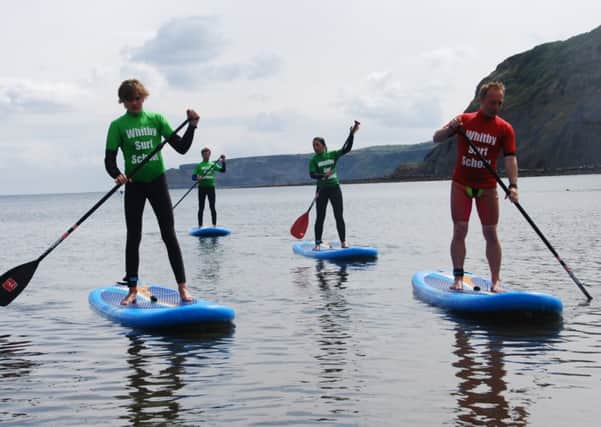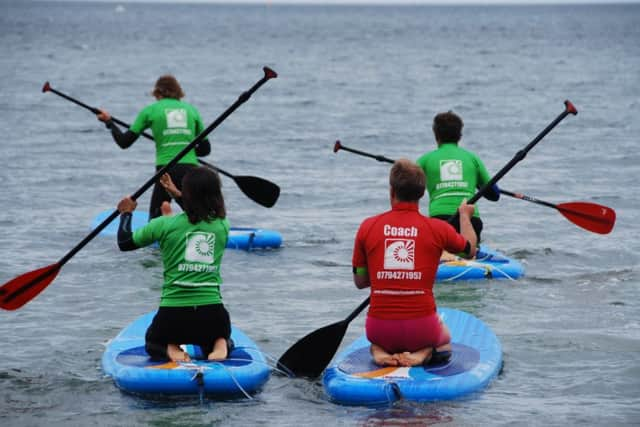All aboard for exploring


The cliff at Kettleness Point, high above the North Sea, is one of the most dramatic spots in Yorkshire. On a clear day there are spectacular views north across to the pristine cottages of Runswick Bay and far beyond. Beneath, more forbiddingly, lie the scaurs and jagged reefs that were once a pitiless graveyard for shipping.
Much of the headland is a barren moonscape, gouged out by centuries of alum works. In the process in 1848 Britain’s biggest fossilised plesiosaur was disgorged here, a 24ft sea monster some 200 million years old.
Advertisement
Hide AdAdvertisement
Hide AdFew people care to make the descent except for wild swimmers, extreme anglers, and dedicated jet and fossil hunters. In fact, since the steepest final section involves clinging onto a rope few people should contemplate it at all without an experienced guide.


So what was I, a senior railcard holder with an accelerating sense of vertigo, doing heading down 375ft of crumbly shale cliff? Fortunately, I was accompanied by two experts and that rope. This was the first leg of a land and sea adventure devised by Whitby Surf School to enjoy the fast growing watersport of stand-up paddleboarding.
Safely down at sea level on a sandy cove, large inflatable surf boards were produced from rucksacks and pumped up. Sam Pepler, owner of the school, chief instructor and all-round aquameister, gave essential instructions on the basics of how to stand up on what appeared to be an outsize ironing board and how to make it go forward and in the right direction. Then on with the wetsuits (horribly unforgiving on your correspondent’s waistline). A leash was attached from board to ankle, and in no time we were pushing out into the bay, kneeling first and then standing, heading for Port Mulgrave, just visible a daunting two sea miles away.
Sam’s coaching worked. I wobbled but I stood up like a toddler taking his first steps. I didn’t fall in. Honest. I did collapse to my knees a couple of times but I didn’t fall in. Sam’s basic promise that ‘Anyone can do it’ was borne out and I certainly qualified as anyone. Certainly someone who has never successfully stood up on a conventional surfboard.
Advertisement
Hide AdAdvertisement
Hide AdThe boards are remarkably stable riding a mild swell. Current and tide were in our favour but dealing with a wind shift that started blowing me in the general direction of Norway was tougher and I was grateful for the comforting presence of a safety boat and a personal escort in the shape (a much better wetsuit shape) of Luke Hutchinson of Staithes who at 17 is a qualified RNLI lifeguard, lifeboat crew member, surfer, appropriately blond, and associate of the Surf School.
Not only did Luke give me a windbreak and paddling tips, he stopped unannounced at an orange buoy, manfully hauled up a hefty lobster pot and produced a quartet of lobsters, two of which were big enough to keep and eat; the others were returned to the sea.
The sun came out on the far side of Runswick Bay, the wind dropped, the going got easier and the pleasures of paddleboarding blossomed. All that ‘at one with nature’ stuff came good. There through clear water on the rocky bottom were starfish; further out to sea were dive-bombing gannets; close by a seal popped up to check out these weird lycra-clad intruders. On the cliffs, invisible from land, appeared the ruins of the aptly-named Wreckhills, a short-lived ironworks that collapsed into the sea in 1858.
And finally, after two hours on the North Sea – ‘The water’s never been warmer,’ according to the ever re-assuring Sam – we made landfall at the extraordinary location of Port Mulgrave, once a full-blown harbour that shipped iron ore to Jarrow and the Tyne, now home to nothing more than a row of ramshackle fishermen’s huts, inaccessible by road, no electricity, no phone. Perfect.
Advertisement
Hide AdAdvertisement
Hide AdSam and Luke led us in. They could probably have made the crossing in half the time. Next was Valeria Misuraca, an Italian from Tuscany , completing her third and longest outing. Yours truly brought up the rear, tired but sneakily pleased with himself for making it at all before discovering that Sam thinks nothing about paddling much longer distances like the 20 mile passage from Scarborough to Whitby.
And there setting up at one of the shacks was Luke’s mother Tricia with a cold beer and a lunch of lobsters from the family pots. Perfect again.
The last leg of the day was a stiff climb up the Port Mulgrave cliff to a road and a waiting car, a stiff climb but this time an easy one. No ropes or vertigo involved.
It had been a trial run for all of us but Sam is a genuine pioneer of paddleboarding along the Yorkshire coast. As well as teaching conventional surfing to all age groups from his base at Whitby’s West Cliff beach, he offers night safaris at Runswick Bay, trips from Robin Hood’s Bay to the seal colony at Ravenscar, and gentler river excursions on the lower reaches of the River Esk.
Advertisement
Hide AdAdvertisement
Hide AdBrought up in Great Fryupdale on the North York Moors and at Sedbergh School in the Yorkshire Dales National Park, it’s hardly surprising that Sam became an outdoor adventurer but it was the surfing bug that transformed the life of a geography and geology graduate, a bug that has seen him surfing round the world for 20 years from Central America to New Zealand.
That Luke Hutchinson of Staithes and Sam Pepler at Whitby should be so closely involved in a surfing and paddleboarding venture rounds off a neat conjunction with history. For it was the great Yorkshire explorer Captain James Cook who had his first taste of the sea at Staithes and began his epic voyages at Whitby and, with his crew, was the first European to see a surfer, in Hawaii in 1778.
“I could not help concluding,” wrote Cook, “that this man had the most supreme pleasure while he was driven so fast and so smoothly by the sea.” That pleasure is now enjoyed along the length of the Yorkshire coast from Saltburn, which can claim to have launched Yorkshire surfing, to Staithes which has a world-class break in winter best left to the experts, on to Sandsend and Whitby and all the way down to Withernsea. OK, it’s not Waikiki but modern wetsuits have changed the boundaries of the sport.
Stand-up paddleboarding is a different thrill again. More people can play and Sam tells me it’s Britain’s fastest growing watersport. It’s undoubtedly at its best in low swell and low wind, and longer trips I’ll leave to the younger and fitter, but as a way of experiencing the otherwise inaccessible corners of Yorkshire’s wonderful coastline, all without the sound of an engine, it felt pretty unbeatable.
• Whitby Surf School paddleboard trips from £35 per person. West Cliff Beach, Whitby YO21 3EN. 07794 271957, www.whitbysurfschool.co.uk